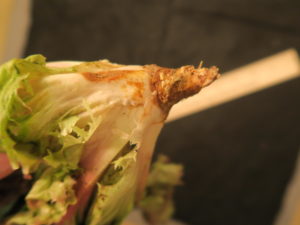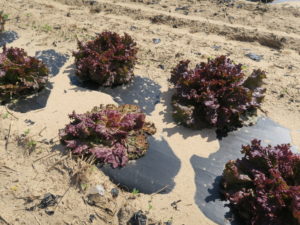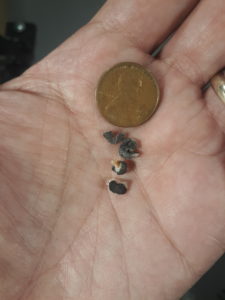Although Indiana is not known for lettuce production, an increasing number of growers find that augmenting retail sales with leaf lettuce can be profitable. Since lettuce is a cool season crop, field planted leaf lettuce around Indiana may be reaching harvest stage. Leaf lettuce can generally be grown with few pests. However, lettuce drop was recently observed in a field of mixed lettuce varieties.
Lettuce affected with lettuce drop often first appears stunted. A closer inspection may reveal that outer leaves are wilted and necrotic (Figure 1). Eventually, the entire plant may die. If the plant is removed from the ground and observed, the leaf ribs that touch the ground may exhibit dark, rotten appearing lesions (Figure 2). The lesions may be associated with dark fungal bodies known as sclerotia (Figure 3). Fortunately, lettuce drop does not often spread from plant to plant. The plants that are diseased will most likely die without spreading the disease to other plants. This fact limits the seriousness of the disease.

Figure 2. Symptoms of lettuce drop may include brown, rotten lesions on leaf mid-ribs. In addition, the stem of the lettuce plant may appear rotten.
The reason that lettuce drop does not spread from plant to plant is that it is caused by a fungus which lives in the soil. The fungus that causes bottom rot is Sclerotinia sclerotiorum. Some growers may recognize this name. S. Sclerotiorum species may cause disease on many different hosts. For example, this fungus may cause white mold of many crops.
There are several cultural methods that can help to reduce the damage caused by this disease. Deep plowing of residue buries the fungus that causes bottom rot. Anything that increases drainage, such as raised beds, should also reduce disease severity. Although no varieties of lettuce are resistant to lettuce drop, growers may notice that varieties vary in resistance. Crop rotation with grain crops such as wheat may help to reduce disease occurrence. Finally, although most growers do not find the disease severity sufficient to require fungicides, several are listed in the Midwest Vegetable Production Guide for Commercial Growers. These fungicides include: Botran 75W, Fontelis, Kenja 400SC, Merivon, Switch 62.5WG and various formulations of ipridione such as Rovral and Nevado. These fungicides vary widely in application methods and pre-harvest intervals. Contans is a product that is a biological control and may be accepted by organic certifying agencies. This product is a fungus that attacks the white mold fungus.
Lettuce drop is usually not a serious disease in Indiana. However, it makes sense to make oneself familiar with the symptoms and management of this disease.
The original article listed bottom rot of lettuce as the cause of the disease in the figures. After additional laboratory work, it was confirmed that lettuce drop is the cause of the disease. The article has been updated to reflect this information.

